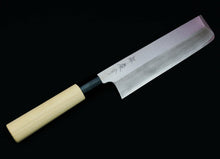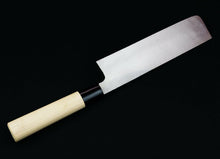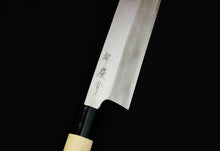
takaramon
Brand New Sakai Keisuke Yasuki Hagane Carbon Steel Usuba Kitchen Knife Cutlery Japan
Condition: Brand New
Brand: Keisuke
Blade material: Yasuki Hagane Steel
Region of Manufacture: Japan
Product Details: Usuba knife
Handle material: Magnolia wood
Specification: For Right Handed Customer
Please choose it among the following various blade length.
Blade length: 165mm/ 180mm/ 210mm
*Attention Customer: The price is charged per each 1 item.
The usuba is a traditional Japanese style knife designed specifically to cut vegetables.
The literal translation of usuba is `thin blade.
’ The Usuba is ideal for cutting vegetables and fruits which are served raw, because the thin and sharp blade produces cut surfaces with very little cell damage, and this minimizes the discoloration and change in flavor often caused by oxidation.
The versatile middle section of the blade can be used for thinly slicing vegetables and also for performing the specialized Katsuramuki ("Rotary peeling”) technique.
The relatively tall and long blade of the Usuba make it ideal for tackling large ingredients, such as cabbages.
However, it is not recommended for cutting vegetables or fruit with hard skins or ingredients other than vegetables, because they may damage the blade. In order to cut meat, it is necessary to use Deba in Japanese knife or Chef's knife in Western knife. Obviously, if you cut meat with a thin blade designed for delicately cutting vegetables, the blade will be chipped.
Sakai knives are carefully made one by one.
They have received good reviews from many professional chefs and now it's said most of the knives they use are from Sakai.
Similar to Japanese swords, Sakai cutlery is also produced through a process of forging.
The features of Sakai cutlery are rooted in superior metalworking and sharpening techniques.
This is a traditional characteristic of Sakai cutlery, recognition of which has resulted in designation as a traditional craft product by the Japanese Minister of Economy, Trade and Industry.
Sakai knives manufacturing process is divided into 3 stages; forging, grinding, and attaching the handle.
It's a division of work in which each craftsman creates using special skills.
In the forging process, the hardness as well as the stickiness of steel are improved in order to make the knife sharp and difficult to chip. There are technical processes such as Hagane-zuke (forging 2 kinds of steel - soft steel and steel), Yaki-Namashi (slowly annealing hot knife-shaped steel), Yaki-ire (immediately chilling steel in the water right after heating it to 780 - 800 degrees), and Yaki-Modoshi (heating steel to 160 - 180 degrees again in the furnace).
In this way, the process of making each product requires very difficult and professional techniques which only experienced craftsmen can perform.
Use & Care
Apply mild detergent on a soft sponge or wet cloth to clean. Do not use bleach. Do not use dishwasher.
Use a clean dry cloth to wipe and dry it immediately after every use.
Use sharpening stones to sharpen Japanese knives do not use a sharpening steel.
For less frequently used knives apply oil very thinly after the knives are sharpened cleaned and dried.
Do not cut frozen foods.
Shipping type:EMS (Express Mail Service) or DHL
Description
Brand New Sakai Keisuke Yasuki Hagane Carbon Steel Usuba Kitchen Knife Cutlery Japan
Condition: Brand New
Brand: Keisuke
Blade material: Yasuki Hagane Steel
Region of Manufacture: Japan
Product Details: Usuba knife
Handle material: Magnolia wood
Specification: For Right Handed Customer
Please choose it among the following various blade length.
Blade length: 165mm/ 180mm/ 210mm
*Attention Customer: The price is charged per each 1 item.
The usuba is a traditional Japanese style knife designed specifically to cut vegetables.
The literal translation of usuba is `thin blade.
’ The Usuba is ideal for cutting vegetables and fruits which are served raw, because the thin and sharp blade produces cut surfaces with very little cell damage, and this minimizes the discoloration and change in flavor often caused by oxidation.
The versatile middle section of the blade can be used for thinly slicing vegetables and also for performing the specialized Katsuramuki ("Rotary peeling”) technique.
The relatively tall and long blade of the Usuba make it ideal for tackling large ingredients, such as cabbages.
However, it is not recommended for cutting vegetables or fruit with hard skins or ingredients other than vegetables, because they may damage the blade. In order to cut meat, it is necessary to use Deba in Japanese knife or Chef's knife in Western knife. Obviously, if you cut meat with a thin blade designed for delicately cutting vegetables, the blade will be chipped.
Sakai knives are carefully made one by one.
They have received good reviews from many professional chefs and now it's said most of the knives they use are from Sakai.
Similar to Japanese swords, Sakai cutlery is also produced through a process of forging.
The features of Sakai cutlery are rooted in superior metalworking and sharpening techniques.
This is a traditional characteristic of Sakai cutlery, recognition of which has resulted in designation as a traditional craft product by the Japanese Minister of Economy, Trade and Industry.
Sakai knives manufacturing process is divided into 3 stages; forging, grinding, and attaching the handle.
It's a division of work in which each craftsman creates using special skills.
In the forging process, the hardness as well as the stickiness of steel are improved in order to make the knife sharp and difficult to chip. There are technical processes such as Hagane-zuke (forging 2 kinds of steel - soft steel and steel), Yaki-Namashi (slowly annealing hot knife-shaped steel), Yaki-ire (immediately chilling steel in the water right after heating it to 780 - 800 degrees), and Yaki-Modoshi (heating steel to 160 - 180 degrees again in the furnace).
In this way, the process of making each product requires very difficult and professional techniques which only experienced craftsmen can perform.
Use & Care
Apply mild detergent on a soft sponge or wet cloth to clean. Do not use bleach. Do not use dishwasher.
Use a clean dry cloth to wipe and dry it immediately after every use.
Use sharpening stones to sharpen Japanese knives do not use a sharpening steel.
For less frequently used knives apply oil very thinly after the knives are sharpened cleaned and dried.
Do not cut frozen foods.
Terms of Sale
The price is charged per each 1 item.
Shipping
Shipping type:EMS (Express Mail Service) or DHL
| Area | Asia | North America Central America Middle East AU, NZ |
Europe Russia |
South America Africa |
|---|---|---|---|---|
| Delivery Days | 3 - 7 days | 3 - 7 days | 3 - 7 days | 4 - 9 days |
--- If your package arrives damaged ---
1. If the package which damaged during delivery are delivered to you because the regular sales products inspected finally in Japan are shipped by all means, please consult with me at first.
2. Futhermore, if the item was broken and delivered, please keep the package and declare the loss or damage to the shipping carrier.
3. Please immediately present the article, the container, wrapping, packaging, and any other contents received in damaged condition to the shipping carrier for inspection, and please fill out a damage report.










